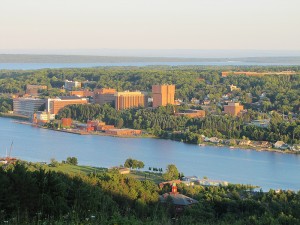PhD student Sean Gohman will present “Deux Lacs, Deux Moulins, et une Ville: The French Mining Experience in Copper Harbor” Friday, Oct. 11, at noon in the Academic Office Building 201.
From Tech Today.
PhD student Sean Gohman will present “Deux Lacs, Deux Moulins, et une Ville: The French Mining Experience in Copper Harbor” Friday, Oct. 11, at noon in the Academic Office Building 201.
From Tech Today.
 Professor Barry Solomon (SS) along with Tapio Litmanen and Mika Kari (University of Jyväskylä) have published a paper, “The Utmost Ends of the Nuclear Fuel Cycle: Finnish Perceptions of the Risks of Uranium Mining and Nuclear Waste Management,” in Journal of Risk Research.
Professor Barry Solomon (SS) along with Tapio Litmanen and Mika Kari (University of Jyväskylä) have published a paper, “The Utmost Ends of the Nuclear Fuel Cycle: Finnish Perceptions of the Risks of Uranium Mining and Nuclear Waste Management,” in Journal of Risk Research.
From Tech Today.

The Life of a Lake: the Geologic and Human History of the Keweenaw Waterway
Take in the Keweenaw’s famous fall colors aboard the Isle Royale Queen IV as Michigan Tech Professors Emeriti Larry Lankton and Bill Rose narrate this cruise to Keweenaw Bay and the historic Jacobsville sandstone quarry and lighthouse. It takes place Saturday, Oct. 5, 2-3:30 p.m. (check in at 1:30), Houghton waterfront west of the bridge, across from Aspirus Keweenaw Medical Arts building. It is also a fundraiser for the Isle Royale and Keweenaw Parks Association, $25 ($20 IRKPA members). Reservations recommended: space is limited, and these speakers are popular. Purchase tickets online at Isle Royale and Keweenaw, call 482-7860, or email kbradof@irkpa.org. Any unsold tickets will go on sale at the dock at 1:00 PM on October 5.
Read more at Tech Today.
Professor Noel Urban (CEE/CWS), Associate Professor Carol MacLennan (SS/CWS), Professor Judith Perlinger (CEE/CWS) and Associate Professor Casey Huckins (Bio Sci/CWS), “Integrated plan to lower toxics exposure from eating Torch Lake fish,” EPA.
From Tech Today.
Social Science Brown Bag Speaker Series
Friday, September 27, 2013, Academic Office Building, Room 201.
Jorge Garcia Fernández will present:
Think Digital: Photogrammetry on Cultural Heritage Documentation
The new capacities and potentialities of digital culture are still unfulfilled in various disciplines. In particular, the use of Digital Photogrammetry linked to Cultural Heritage documentation, interpretation, and communication processes is starting to be seen not only as a tool, but also as a new intervention method. This new approach is bringing big gains in accuracy, applicability, and affordability in the CH field.
Jorge Garcia Fernández is a Architect and PhD Candidate, Laboratorio de Fotogrametría Arquitectónica, ETS Arquitectura Universidad de Valladolid, Spain

As the representatives of some sixty nations were lining up in Hancock for the Parade of Nations, the sun came out and it was starting to warm up.
Nearby, Social Sciences Professor Mary Durfee was gathered with a group of students from Malta. They are attempting to create the first international chapter of MindTrekkers, that fantastic traveling science demonstration that has enthralled school kids around the Midwest and in DC.
Read more at Here, There, and Everywhere in TechAlum Newsletter, by Dennis Walikainen.
 Emma S. Norman (SS and GLRC) just published the co-edited volume, Water without Borders? Canada, the United States and Shared Waters through University of Toronto Press.
Emma S. Norman (SS and GLRC) just published the co-edited volume, Water without Borders? Canada, the United States and Shared Waters through University of Toronto Press.
From Tech Today.
Louise Nelson Dyble, former assistant professor of social sciences, has received the American Public Works Association (APWA) Michael Robinson Award for her article “Tolls and Control: the Chicago Skyway and the Pennsylvania Turnpike.”
The award is presented by APWA’s Public Works Historical Society and recognizes the best essay or article published on a public works historical topic. Dyble’s article, published in 2012 in the Journal of Planning History, provides a historical perspective on two high-profile toll roads: the Pennsylvania Turnpike, operated by an independent public authority, and the Chicago Skyway, originally built and managed by the City of Chicago.
Dyble notes that great public works have resulted from cooperation among governments, and that the lack of cooperation is one of our society’s greatest obstacles. “Embattled cities, balkanized regions and dysfunctional states can’t support the infrastructure systems that we need,” she said.
Dyble is a member of the Public Works Historical Society’s Board of Trustees and is pursuing a law degree at the University of California, Berkeley.
From Tech Today.

Associate Professor Tim Scarlett (SS) was recognized by the Utah Division of State History for his archeological work with Utah’s early pottery. He won one of five awards for outstanding contribution in history. The 2013 awards were presented at the Utah State History Conference earlier this month.
Scarlett “has promoted history and historical archeology in Utah, bringing to light Utah’s unique early pottery,” the Division of State History said in a news release about the awards. “His studies, excavations and publications have brought Utah pottery to an international audience. His work led to the first formal exhibition of early-pioneer ceramics and pottery at the Frontier Homestead Museum in Cedar City, Utah. He involves the public in innovative ways in discovery and has had an incalculable influence in training students to continue the work.”
The organization also presented awards for articles and books about Utah history.
From Tech Today.
 Study and travel in England and Scotland in the summer of 2014! For the fifth year the faculty-led study abroad program, Frontiers and Fortresses will take students to England for four weeks during Track B for a 3 course, 9 credit program. Please see the F&F full information 2014, or contact Dr. Carl Blair, the program leader, for more information.
Study and travel in England and Scotland in the summer of 2014! For the fifth year the faculty-led study abroad program, Frontiers and Fortresses will take students to England for four weeks during Track B for a 3 course, 9 credit program. Please see the F&F full information 2014, or contact Dr. Carl Blair, the program leader, for more information.